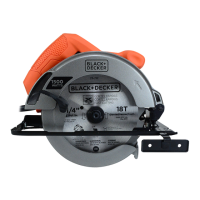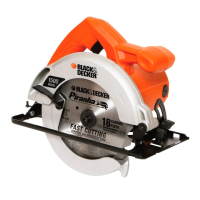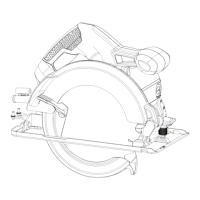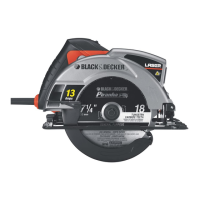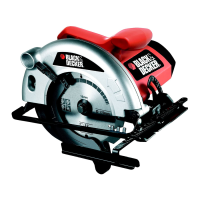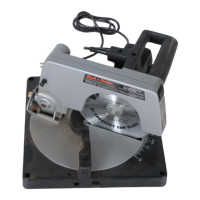7
ENGLISH
(Original instructions)
it may cause binding and kickback.
u Use extra caution when making a "plunge cut" into
existing walls or other blind areas. The protruding blade
may cut objects that can cause kickback.
Safety instructions for circular saws with outer or
inner pendulum guards and with tow guard
u Check lower guard for proper closing before each
use.
Do not operate the saw if lower guard does not
move freely and close instantly. Never clamp or tie the
lower guard into the open position. If saw is
accidentally dropped, lower guard may be bent. Raise the
lower guard with the retracting handle and make sure it
moves freely and does not touch the blade or any other
part, in all angles and depths of cut.
u Check the operation of the lower guard spring. If the
guard and the spring are not operating properly, they
must be serviced before use. Lower guard may operate
sluggishly due to damaged parts, gummy deposits, or a
build-up of debris.
u Lower guard should be retracted manually only for
special cuts such as "plunge cuts" and "compound
cuts". Raise lower guard by retracting handle and as
soon as blade enters the material, the lower guard
must be released. For all other sawing, the lower guard
should operate automatically.
u Always observe that the lower guard is covering the
blade before placing saw down on bench or oor. An
unprotected, coasting blade will cause the saw to walk
backwards, cutting whatever is in its path. Be aware of the
time it takes for the blade to stop after switch is released.
Residual risks
Additional residual risks may arise when using the tool which
may not be included in the enclosed safety warnings. These
risks can arise from misuse, prolonged use etc.
Even with the application of the relevant safety regulations
and the implementation of safety devices, certain residual
risks can not be avoided. These include:
u Injuries caused by touching any rotating/moving parts.
u Injuries caused when changing any parts, blades or ac-
cessories.
u Injuries caused by prolonged use of a tool. When using
any tool for prolonged periods ensure you take regular
breaks.
u Impairment of hearing.
u Health hazards caused by breathing dust developed when
using your tool (example:- working with wood, especially
oak, beech and MDF.).
Laser (CS1250L only)
u This laser complies with class 2 according to EN60825-
1:2014. Do not replace a laser diode with a different type.
If the laser is damaged, have the laser repaired by an
authorised repair agent.
u Do not use the laser for any purpose other than projecting
laser lines.
u An exposure of the eye to the beam of a class 2 laser is
considered safe for a maximum of 0.25 seconds. Eyelid
reexes will normally provide adequate protection.
At distances greater than 1m, the laser complies with
class 1 and is therefore considered completely safe.
u Never look into the laser beam directly and intentionally.
u Do not use optical tools to view the laser beam.
u Do not set up the tool where the laser beam can cross any
person at head height.
u Do not let children come near the laser.
Saw blades
u Do not use blades of larger or smaller diameter than
recommended. For the proper blade rating refer to the
technical data. Use only the blades specied in this
manual, complying with EN 847-1.
u Warning! Never use abrasive wheels.
Safety of others
u Warning! Wear ear protection when using this tool
u This appliance is not intended for use by persons
(including children) with reduced physical, sensory or
mental capabilities, or lack of experience and knowledge,
unless they have been given supervision or instruction
concerning use of the appliance by a person responsible
for their safety.
u Children should be supervised to ensure that they do not
play with the appliance.
Vibration
The declared vibration emission values stated in the technical
data and the declaration of conformity have been measured
in accordance with a standard test method provided by EN
62841 and may be used for comparing one tool with another.
The declared vibration emission value may also be used in a
preliminary assessment of exposure.
Warning! The vibration emission value during actual use of
the power tool can differ from the declared value depending
on the ways in which the tool is used. The vibration level may
increase above the level stated.

